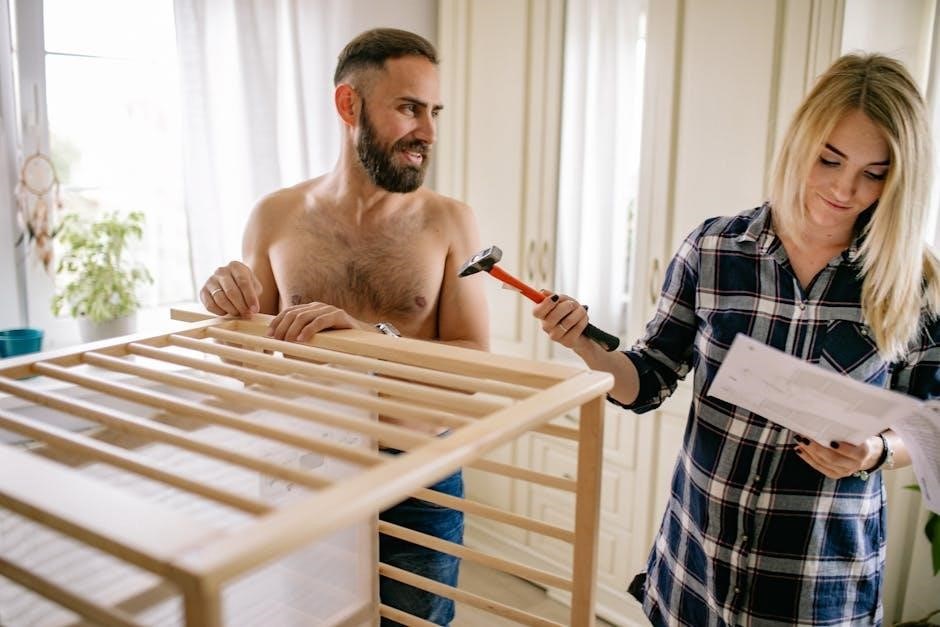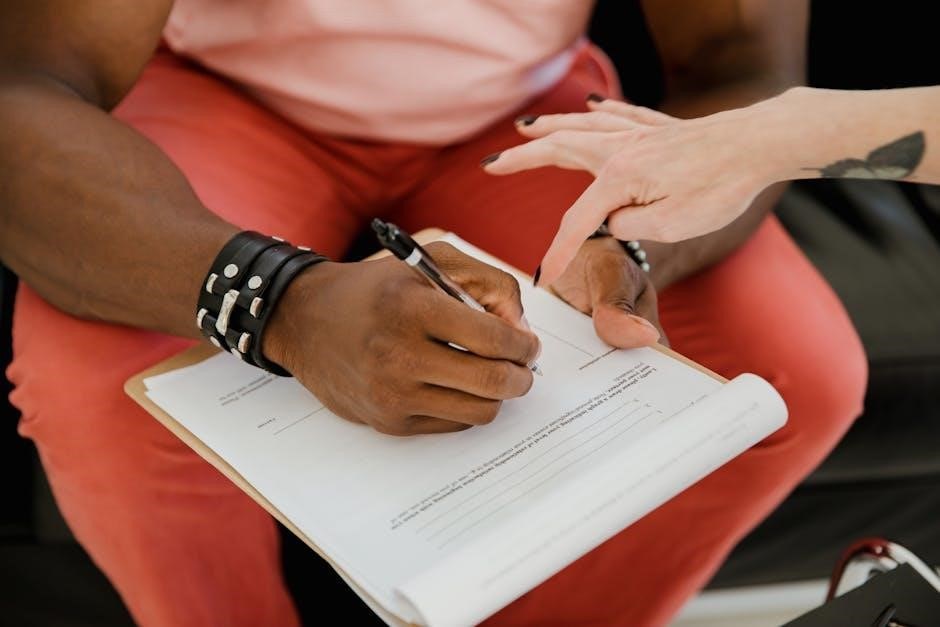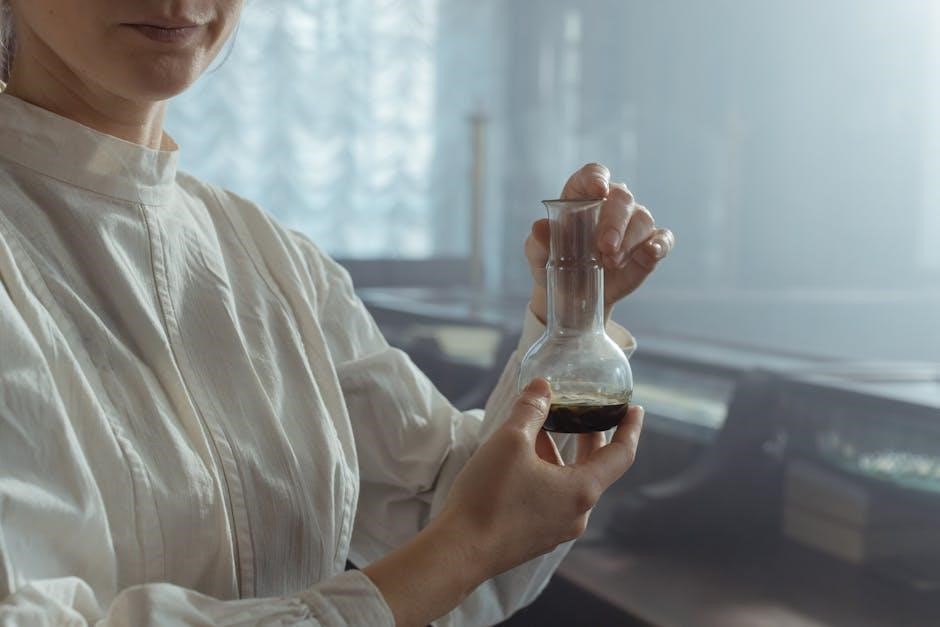Welcome to the pool pump instruction manual, your guide to understanding and maintaining your pump․ This manual provides essential information for safe and efficient operation, ensuring optimal performance and longevity of your equipment․ Proper use and maintenance will help prevent damage and ensure your pool remains clean and hygienic․ Always follow safety guidelines and instructions carefully to avoid risks and maintain functionality․ This manual is designed to assist you in getting the most out of your pool pump with clear, step-by-step instructions and helpful tips․ By adhering to the guidelines outlined, you can enjoy a trouble-free swimming experience and extend the lifespan of your pump․ Let’s dive into the details to ensure your pool operates smoothly and safely․
1․1 Importance of Reading the Manual
Reading this manual is crucial for the safe and efficient operation of your pool pump․ Failure to follow instructions can lead to electric shock, pump damage, or poor performance․ The manual provides essential safety warnings, installation guidelines, and maintenance tips to ensure optimal functionality․ By understanding the pump’s components and proper usage, you can prevent accidents and extend its lifespan; Ignoring the manual may result in voiding the warranty or causing irreversible damage․ Take the time to review each section carefully to ensure safe and effective operation of your pool pump throughout its service life․
1․2 Overview of Pool Pump Functions
Your pool pump is designed to circulate and filter water, ensuring a clean and hygienic swimming environment․ It operates by drawing water from the pool, pushing it through the filter, and redistributing it back into the pool․ The pump is typically electric, requiring a power supply, and features a control panel for operation․ Its primary functions include maintaining consistent water flow, preventing stagnation, and supporting the pool’s filtration system․ Regular operation helps reduce the need for chemical treatments and keeps the water clear․ Designed for both in-ground and above-ground pools, the pump ensures efficient water circulation, promoting a safe and enjoyable swimming experience․ Proper installation and maintenance are essential for optimal performance․ By following the manual, you can ensure the pump functions smoothly, extending its lifespan and keeping your pool clean year-round․
1․3 Safety Precautions
Safety is paramount when operating your pool pump․ Always ensure the pump is installed and maintained by a qualified professional to avoid electrical hazards․ Before performing any maintenance, disconnect the power supply to prevent accidental start-ups․ Never operate the pump if the power cord or motor housing is damaged, as this can lead to electric shock․ Keep children and pets away from the pump to avoid accidents․ Use the pump only for its intended purpose and follow all local electrical safety standards․ Regularly inspect the pump and its connections to ensure they are in good condition․ Failure to adhere to these precautions can result in injury or equipment damage․ Always prioritize safety to ensure a secure and efficient operation of your pool pump․

Safety Guidelines
Adhere to all safety guidelines to ensure safe and efficient pool pump operation․ Proper installation, electrical precautions, and regular inspections are crucial to prevent hazards and maintain functionality․
2․1 General Safety Warnings
Always read and follow the safety guidelines to prevent accidents and ensure proper pump operation․ Never operate the pump if the power cord or motor housing is damaged, as this could cause electric shock․ Keep the pump away from flammable materials and ensure it is used only for its intended purpose․ Avoid overloading the pump, and never touch electrical components with wet hands․ Regularly inspect the pump and its connections to prevent malfunctions․ Use the pump only with storable pools, as specified, and avoid any modifications that could compromise safety․ Proper maintenance and adherence to these warnings are crucial for safe and efficient operation․
2․2 Electrical Safety Precautions
Always ensure the pump is connected to a properly located electrical outlet and avoid using damaged power cords or connectors․ Never operate the pump if the motor housing or connections are compromised, as this can cause electric shock․ Keep the pump and its electrical components away from water to prevent accidental exposure․ Disconnect the pump from the power supply before performing any maintenance or repairs․ Ensure all electrical installations are carried out by a qualified electrician․ Avoid using extension cords unless they are rated for the pump’s power requirements․ Adhere to these precautions to maintain safety and prevent electrical hazards during operation․

2․3 Proper Use of the Pump
Ensure the pump is installed in a well-ventilated area, away from direct sunlight and moisture․ Operate the pump only for its intended purpose, such as circulating and filtering pool water․ Avoid running the pump continuously for extended periods unless specified․ Always follow the recommended flow rates and pressure settings to prevent overload․ Do not use the pump for purposes other than those outlined in this manual, such as draining non-pool water or operating with chemicals beyond the recommended levels․ Regularly inspect the pump and its connections to ensure proper function․ Proper use will extend the pump’s lifespan and maintain optimal performance․
2․4 Emergency Procedures
In case of an emergency, immediately switch off the pump and disconnect it from the power supply․ If the pump is damaged or leaking, do not attempt to operate it․ Check for any visible damage, such as a cracked housing or frayed cords, and contact a professional for repairs․ If water is leaking, turn off the pool system and inspect the connections․ Never touch electrical components with wet hands or while standing in water to avoid electric shock․ Keep the pump area clear of debris and ensure proper ventilation․ Follow these steps to prevent accidents and ensure safe operation․

Installation Instructions
Ensure the pump is installed on a level surface, away from water splashing․ Connect the pump to the pool system securely, following the manufacturer’s guidelines․ Proper installation ensures efficient operation and longevity of the pump․ Always prime the pump before initial start-up to remove air pockets․ Ensure all connections are tight and electrical components are protected from water exposure․ Follow the step-by-step instructions carefully to avoid installation errors․ Test the pump after installation to confirm it operates smoothly and efficiently․
3․1 Choosing the Right Location
Choosing the right location for your pool pump is crucial for efficient operation and safety․ Select a level, stable surface away from water splashing to prevent electrical hazards․ Ensure the area has good drainage to avoid water accumulation․ The pump should be installed near the pool to minimize pipe length and reduce pressure loss․ It should also be accessible for maintenance and protected from direct sunlight and extreme weather conditions․ Ensure the location is close to a power source and follows local electrical regulations․ Proper placement will enhance performance, reduce noise, and ensure longevity of the pump․ Plan carefully for optimal results․
3․2 Connecting the Pump to the Pool System
Connect the pump to the pool system by attaching the inlet and outlet pipes according to the manufacturer’s specifications․ Ensure the pipes are securely fitted with unions for easy maintenance․ The inlet should draw water from the pool’s skimmer or drain, while the outlet directs filtered water back into the pool․ Use the correct pipe sizes to maintain proper flow rate and pressure․ Avoid kinking or bending the pipes to prevent restriction․ Before powering on, check all connections for leaks and ensure the system is correctly primed․ Proper connections are essential for efficient operation and to prevent damage to the pump or pool system․
3․3 Priming the Pump
Priming the pump is essential to remove air from the system and ensure proper water flow․ Locate the priming port on the pump and open it by turning the valve counterclockwise․ Allow water to flow through the port until it exits without air bubbles․ Close the valve once water flows steadily․ Check all connections for leaks and ensure they are secure․ If the pump does not prime, repeat the process or consult the troubleshooting section․ Proper priming prevents damage and ensures efficient operation․ Always prime the pump before initial start-up and after maintenance to maintain optimal performance and prevent overheating․
3․4 Initial Start-Up Procedure
Ensure the pump is properly primed and all electrical connections are secure․ Inspect the power cord for damage․ Plug in the pump and turn it on․ Let it run for a few minutes to check for smooth operation and any leaks․ Listen for unusual noises and ensure the flow rate is as expected․ If everything functions correctly, the pump is ready for regular use․ If issues arise, refer to the troubleshooting section; Proper initial start-up ensures efficient and safe operation, prolonging the pump’s lifespan․

Operating the Pool Pump
Operating the pool pump involves understanding the control panel, setting the timer, and monitoring performance․ Adjust settings as needed for optimal water circulation and efficiency․
4․1 Understanding the Control Panel

The control panel is the central interface for managing your pool pump․ It typically features buttons for power, speed adjustment, and timer settings․ The display screen shows operational status, such as current speed, timer, and error codes․ Understanding each button and its function is crucial for efficient operation․ Familiarize yourself with the layout to adjust settings easily․ Refer to the manual for specific button functions, as designs may vary․ Proper use of the control panel ensures optimal pump performance and energy efficiency․ Always follow the manufacturer’s guidelines for operation to maintain safety and functionality; Regularly check the display for any alerts or issues․
4․2 Setting the Pump Timer
Setting the pump timer allows you to automate operation, optimizing energy use and pool maintenance․ Locate the timer button on the control panel and press to access the menu․ Use the arrows to set the desired start and end times, ensuring the pump runs during off-peak hours․ Confirm the settings to activate the timer․ Some models may require additional steps, so consult your manual for specific instructions․ Proper timer setup ensures consistent water circulation and filtration, maintaining your pool’s clarity and safety․ Regularly review and adjust the timer to accommodate seasonal changes or varying usage patterns․ This feature enhances efficiency and convenience․ Always test the timer to ensure it functions correctly before relying on it for automated operation․
4․3 Monitoring Pump Performance
Regularly monitoring your pool pump’s performance ensures efficient operation and extends its lifespan․ Check the pressure gauge to confirm it operates within the recommended range․ Listen for unusual noises, such as grinding or rattling, which may indicate worn or loose parts․ Inspect the pump for leaks or excessive vibration, as these can signal issues like misalignment or seal damage․ Ensure proper water flow by verifying the inlet and outlet are clear of debris․ Monitor energy consumption to detect irregularities․ Address any anomalies promptly to prevent damage․ Refer to the troubleshooting section for solutions to common issues․ Consistent monitoring ensures optimal performance and safety․ Always prioritize early detection to avoid costly repairs and maintain your pool’s hygiene․ Regular checks are essential for seamless operation and longevity of the pump․

Maintenance and Care
Regular maintenance ensures your pool pump operates efficiently and lasts longer․ Clean the filter and impeller regularly, lubricate moving parts, and winterize the pump to prevent damage․ Always inspect for wear and tear, and address issues promptly to maintain optimal performance and extend the pump’s lifespan․ Proper care ensures reliable operation and keeps your pool clean and safe․ Follow the manufacturer’s guidelines for maintenance schedules and procedures to ensure your pump continues to function effectively throughout the year․ Regular upkeep is crucial for maintaining your pool’s hygiene and extending the pump’s service life․ Consistent care ensures smooth operation and prevents costly repairs․ Always prioritize routine checks to keep your pool pump running efficiently․ Regular cleaning and lubrication are essential for maintaining performance and longevity․ Winterizing the pump prevents freezing and damage during colder months․ By following these steps, you can ensure your pool pump remains in excellent condition year-round․ Always refer to the manual for specific maintenance instructions tailored to your pump model․ Proper care ensures your pool remains clean, safe, and enjoyable․ Regular maintenance is key to extending the lifespan of your pool pump and maintaining its efficiency․ Always inspect and clean the pump regularly to prevent debris buildup and ensure smooth operation․ Lubricating moving parts reduces friction and wear, while winterizing protects the pump from freezing temperatures․ Follow the recommended maintenance schedule to keep your pool pump running optimally․ Regular care ensures your pool remains clean and hygienic, while also preventing costly repairs․ Always prioritize maintenance to extend the lifespan of your pool pump and maintain its performance․ Regular cleaning, lubrication, and winterizing are essential for optimal operation and longevity․ Follow the manufacturer’s guidelines to ensure your pool pump continues to function effectively․ Proper maintenance ensures your pool remains clean and safe, while also extending the pump’s service life․ Regular upkeep is crucial for maintaining your pool’s hygiene and ensuring smooth operation․ Always inspect and maintain your pool pump regularly to prevent issues and ensure efficiency․ Regular maintenance ensures your pool pump operates effectively and lasts longer, keeping your pool clean and safe․ Follow the manual’s guidelines for routine care and troubleshooting to ensure optimal performance and longevity․ Always prioritize regular maintenance to keep your pool pump running smoothly and efficiently․ Regular checks and proper care ensure your pool remains clean and hygienic, while extending the pump’s lifespan․ Maintenance is essential for preventing damage and ensuring reliable operation․ Always follow the manufacturer’s instructions for cleaning, lubricating, and winterizing your pool pump․ Regular upkeep ensures your pool pump continues to function effectively and efficiently․ Proper care extends the pump’s lifespan and maintains your pool’s cleanliness․ Always inspect and maintain your pool pump regularly to ensure optimal performance and prevent costly repairs․ Regular maintenance is crucial for keeping your pool pump running smoothly and efficiently․ Follow the manual’s guidelines for routine care and troubleshooting to ensure your pool remains clean and safe․ Always prioritize regular maintenance to extend the lifespan of your pool pump and maintain its performance․ Regular cleaning, lubrication, and winterizing are essential for optimal operation and longevity․ Proper care ensures your pool pump continues to function effectively and efficiently․ Always refer to the manual for specific maintenance instructions tailored to your pump model․ Maintenance ensures your pool remains clean and hygienic, while also extending the pump’s service life․ Regular upkeep is crucial for maintaining your pool’s hygiene and ensuring smooth operation․ Always inspect and maintain your pool pump regularly to prevent issues and ensure efficiency; Regular maintenance ensures your pool pump operates effectively and lasts longer, keeping your pool clean and safe․ Follow the manual’s guidelines for routine care and troubleshooting to ensure optimal performance and longevity․ Always prioritize regular maintenance to keep your pool pump running smoothly and efficiently․ Regular checks and proper care ensure your pool remains clean and hygienic, while extending the pump’s lifespan․ Maintenance is essential for preventing damage and ensuring reliable operation․ Always follow the manufacturer’s instructions for cleaning, lubricating, and winterizing your pool pump․ Regular upkeep ensures your pool pump continues to function effectively and efficiently․ Proper care extends the pump’s lifespan and maintains your pool’s cleanliness․ Always inspect and maintain your pool pump regularly to ensure optimal performance and prevent costly repairs․ Regular maintenance is crucial for keeping your pool pump running smoothly and efficiently․ Follow the manual’s guidelines for routine care and troubleshooting to ensure your pool remains clean and safe․ Always prioritize regular maintenance to extend the lifespan of your pool pump and maintain its performance․ Regular cleaning, lubrication, and winterizing are essential for optimal operation and longevity․ Proper care ensures your pool pump continues to function effectively and efficiently․ Always refer to the manual for specific maintenance instructions tailored to your pump model․ Maintenance ensures your pool remains clean and hygienic, while also extending the pump’s service life․ Regular upkeep is crucial for maintaining your pool’s hygiene and ensuring smooth operation․ Always inspect and maintain your pool pump regularly to prevent issues and ensure efficiency․ Regular maintenance ensures your pool pump operates effectively and lasts longer, keeping your pool clean and safe․ Follow the manual’s guidelines for routine care and troubleshooting to ensure optimal performance and longevity․ Always prioritize regular maintenance to keep your pool pump running smoothly and efficiently․ Regular checks and proper care ensure your pool remains clean and hygienic, while extending the pump’s lifespan․ Maintenance is essential for preventing damage and ensuring reliable operation․ Always follow the manufacturer’s instructions for cleaning, lubricating, and winterizing your pool pump․ Regular upkeep ensures your pool pump continues to function effectively and efficiently․ Proper care extends the pump’s lifespan and maintains your pool’s cleanliness․ Always inspect and maintain your pool pump regularly to ensure optimal performance and prevent costly repairs․ Regular maintenance is crucial for keeping your pool pump running smoothly and efficiently․ Follow the manual’s guidelines for routine care and troubleshooting to ensure your pool remains clean and safe․ Always prioritize regular maintenance to extend the lifespan of your pool pump and maintain its performance․ Regular cleaning, lubrication, and winterizing are essential for optimal operation and longevity․ Proper care ensures your pool pump continues to function effectively and efficiently․ Always refer to the manual for specific maintenance instructions tailored to your pump model․ Maintenance ensures your pool remains clean and hygienic, while also extending the pump’s service life․ Regular upkeep is crucial for maintaining your pool’s hygiene and ensuring smooth operation․ Always inspect and maintain your pool pump regularly to prevent issues and ensure efficiency․ Regular maintenance ensures your pool pump operates effectively and lasts longer, keeping your pool clean and safe․ Follow the manual’s guidelines for routine care and troubleshooting to ensure optimal performance and longevity․ Always prioritize regular maintenance to keep your pool pump running smoothly and efficiently․ Regular checks and proper care ensure your pool remains clean and hygienic, while extending the pump’s lifespan․ Maintenance is essential for preventing damage and ensuring reliable operation․ Always follow the manufacturer’s instructions for cleaning, lubricating, and winterizing your pool pump․ Regular upkeep ensures your pool pump continues to function effectively and efficiently․ Proper care extends the pump’s lifespan and maintains your pool’s cleanliness․ Always inspect and maintain your pool pump regularly to ensure optimal performance and prevent costly repairs․ Regular maintenance is crucial for keeping your pool pump running smoothly and efficiently․ Follow the manual’s guidelines for routine care and troubleshooting to ensure your pool remains clean and safe․ Always prioritize regular maintenance to extend the lifespan of your pool pump and maintain its performance․ Regular cleaning, lubrication, and winterizing are essential for optimal operation and longevity․ Proper care ensures your pool pump continues to function effectively and efficiently․ Always refer to the manual for specific maintenance instructions tailored to your pump model․ Maintenance ensures your pool remains clean and hygienic, while also extending the pump’s service life․ Regular upkeep is crucial for maintaining your pool’s hygiene and ensuring smooth operation․ Always inspect and maintain your pool pump regularly to prevent issues and ensure efficiency․ Regular maintenance ensures your pool pump operates effectively and lasts longer, keeping your pool clean and safe․ Follow the manual’s guidelines for routine care and troubleshooting to ensure optimal performance and longevity․ Always prioritize regular maintenance to keep your pool pump running smoothly and efficiently․ Regular checks and proper care ensure your pool remains clean and hygienic, while extending the pump’s lifespan․ Maintenance is essential for preventing damage and ensuring reliable operation․ Always follow the manufacturer’s instructions for cleaning, lubricating, and winterizing your pool pump․ Regular upkeep ensures your pool pump continues to function effectively and efficiently․ Proper care extends the pump’s lifespan and maintains your pool’s cleanliness․ Always inspect and maintain your pool pump regularly to ensure optimal performance and prevent costly repairs․ Regular maintenance is crucial for keeping your pool pump running smoothly and efficiently․ Follow the manual’s guidelines for routine care and troubleshooting to ensure your pool remains clean and safe․ Always prioritize regular maintenance to extend the lifespan of your pool pump and maintain its performance․ Regular cleaning, lubrication, and winterizing are essential for optimal operation and longevity․ Proper care ensures your pool pump continues to function effectively and efficiently․
5․1 Regular Cleaning and Inspection
Regular cleaning and inspection are crucial for maintaining your pool pump’s efficiency and longevity․ Start by turning off the power and disconnecting the pump․ Clean the impeller and filter regularly to remove debris, ensuring proper water flow․ Inspect the pump housing for dirt or mineral buildup and scrub it gently with a soft brush․ Check hoses and connections for leaks or damage․ Lubricate moving parts as recommended to reduce friction and wear․ Regular inspection helps identify potential issues early, preventing costly repairs․ Always follow the manufacturer’s cleaning instructions to avoid damaging components․ Consistent maintenance ensures optimal performance and extends the pump’s lifespan․
5․2 Lubricating Moving Parts
Lubricating moving parts is essential to reduce friction and wear, ensuring smooth operation and extending the pump’s lifespan․ Use a silicone-based grease recommended by the manufacturer to lubricate the motor shaft, bearings, and other moving components․ Apply a small amount to the specified areas, avoiding over-lubrication, which can attract dirt and cause damage․ Turn off the pump before lubricating and ensure all parts are clean․ Regular lubrication should be performed as outlined in the maintenance schedule․ Proper lubrication prevents overheating and premature wear, keeping the pump running efficiently․ Always refer to the manual for specific lubrication intervals and methods․
5․3 Winterizing the Pump
Winterizing your pool pump is crucial to protect it from freezing temperatures and damage․ Drain all water from the pump and connected pipes to prevent ice formation․ Disconnect hoses and store them in a dry place․ Use a pump winterizing kit or blow out remaining water with a blower․ Apply a rust-inhibiting lubricant to moving parts and cover the pump to shield it from moisture․ Store the pump in a frost-free area if possible․ Follow the manufacturer’s winterizing instructions to ensure proper preparation․ Neglecting this step can lead to costly repairs․ Proper winterization extends the pump’s lifespan and ensures smooth operation next season․

Troubleshooting Common Issues
Identify and resolve common pool pump issues like low water pressure, leaks, or noise․ Check for blockages, loose connections, or worn parts․ Consult the manual for solutions or contact support if problems persist․
6․1 Low Water Pressure
Low water pressure in your pool pump can indicate blockages, improper sizing, or debris buildup․ Check the filter and skimmer for cleanliness and ensure all valves are fully open․ Inspect the pump basket for clogs and verify that the pump is correctly sized for your pool․ If issues persist, examine the suction and return lines for leaks or kinks․ Ensure the pump is primed properly and consult the manual for troubleshooting guides․ Addressing these factors can restore optimal water flow and maintain efficient pool circulation․ Regular maintenance will help prevent future pressure problems and keep your pool system running smoothly․
6․2 Pump Not Turning On
If your pool pump fails to start, first ensure the power supply is stable and the circuit breaker hasn’t tripped․ Check the power cord for damage and verify the outlet is functioning․ Make sure the pump switch is in the “on” position and all connections are secure․ Inspect the motor for overheating signs and ensure no safety features have been triggered․ Consult the manual for specific troubleshooting steps, as some models may have unique reset procedures․ If the issue persists, contact a professional or customer support for assistance․ Always prioritize safety when diagnosing electrical issues to avoid potential hazards․
6;3 Leaks and Noise Problems
Leakage and excessive noise are common issues that may arise with your pool pump․ To address leaks, inspect all connections, seals, and gaskets for wear or damage․ Tighten any loose fittings and replace worn-out parts immediately․ For noise problems, check if the pump is properly balanced or if debris is causing vibration․ Ensure the pump is installed on a level surface and lubricate moving parts as needed․ Regular maintenance, such as cleaning the impeller, can also reduce noise․ If issues persist, consult the manual or contact a professional to avoid further damage․ Addressing these problems promptly ensures efficient and quiet operation․

Parts and Accessories
This section details the components and accessories required for pool pump operation, ensuring compatibility and optimal performance․ Proper parts ensure efficient and safe functionality always․
7․1 Identifying Pump Components
Identifying pool pump components is crucial for proper installation and maintenance․ Key parts include the motor, impeller, inlet/outlet connectors, and housing․ The motor powers the pump, while the impeller drives water flow․ Inlet and outlet connectors link the pump to the pool system․ The housing protects internal components․ Additional accessories like power cords and fittings ensure safe and efficient operation․ Understanding each part’s function helps in troubleshooting and replacing worn-out elements․ Always refer to the manual for specific component details and compatibility․ Proper identification ensures correct installation and maintenance, prolonging the pump’s lifespan and optimizing performance․ Familiarize yourself with these components for effective use․
7․2 Replacing Worn-Out Parts
Replacing worn-out parts is essential for maintaining your pool pump’s efficiency and longevity․ Always refer to the manual for specific instructions and compatible replacement parts․ Turn off and disconnect the power supply before starting any replacement to ensure safety․ Common parts that may need replacement include the impeller, gaskets, and seals․ Use genuine or recommended parts to maintain performance and avoid damage․ Regularly inspecting and replacing worn components prevents leaks, noise, and reduced water flow․ Keep spare parts handy and follow proper installation steps to ensure a secure fit․ Proper replacement procedures prevent further damage and extend the pump’s operational life․
7․3 Recommended Tools and Materials
To maintain and repair your pool pump effectively, ensure you have the right tools and materials․ Essential tools include a screwdriver, pliers, wrench, and a bucket for draining water․ For replacements, use genuine or compatible parts to avoid compromising performance․ Teflon tape is recommended for threaded connections to prevent leaks․ Silicone-based lubricants can be used for moving parts to reduce friction and wear․ Always refer to the manual for specific tool recommendations tailored to your pump model․ Using the correct materials ensures safety, durability, and optimal functionality․ Avoid using abrasive or incompatible materials that could damage the pump or its components․

By following this manual, you’ll ensure your pool pump operates efficiently and safely․ Regular maintenance and adherence to guidelines will extend its lifespan and performance․ If issues arise, contact customer support for assistance․ Happy swimming!
8․2 Contacting Customer Support
8․1 Summary of Key Points
This manual has provided comprehensive guidance on pool pump installation, operation, and maintenance․ Key points include prioritizing safety, proper installation, regular maintenance, and troubleshooting common issues․ Always follow safety precautions to avoid electrical hazards and ensure efficient pump performance․ Regular cleaning, inspection, and lubrication are crucial for longevity․ Understanding the control panel and timer settings helps optimize pump operation․ In case of issues, refer to the troubleshooting section or contact customer support․ By adhering to these guidelines, you can ensure your pool remains clean, hygienic, and enjoyable while extending the lifespan of your pump․ Proper care ensures reliable and efficient performance․
